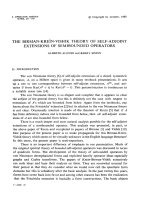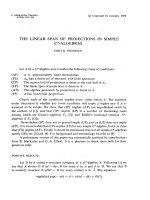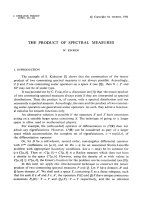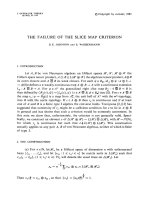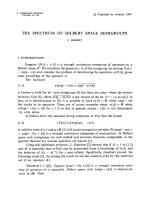Báo cáo toán học: "The characteristic polynomial of a graph is reconstructible from the characteristic polynomials of its vertex-deleted subgraphs and their complements" doc
Bạn đang xem bản rút gọn của tài liệu. Xem và tải ngay bản đầy đủ của tài liệu tại đây (113.87 KB, 9 trang )
The characteristic polynomial of a graph is
reconstructible from the characteristic polynomials of
its vertex-deleted subgraphs and their complements
Elias M. Hagos
Submitted: June 10, 1999; Accepted: February 13, 2000.
Abstract
The question of whether the characteristic polynomial of a simple graph is
uniquely determined by the characteristic polynomials of its vertex-deleted sub-
graphs is one of the many unresolved problems in graph reconstruction. In this
paper we prove that the characteristic polynomial of a graph is reconstructible
from the characteristic polynomials of the vertex-deleted subgraphs of the graph
and its complement.
AMS Classification Numbers: 05C60, 05C50
1 Introduction
Let G =(V,E) be a simple graph with a vertex set of at least three elements V =
{1, ,n}. WedenotebyE(G) the set of its edges. A subgraph of G obtained by
deleting vertex i and all its incident edges is called a vertex-deleted subgraph of G and
is denoted by G
i
. The collection of vertex-deleted subgraphs of G is known as its deck.
The characteristic polynomial of G is the characteristic polynomial of its adjacency
matrix A and is defined by P
G
(x)=det(xI − A). We call the collection of the char-
acteristic polynomials of the vertex-deleted subgraphs the polynomial deck of G and
denote it by P(G)={P
G
1
,P
G
2
, ,P
G
n
}. In general, a property of a graph is said
to be reconstructible if it is uniquely determined by its deck. Tutte [11] proved that
the characteristic polynomial of a graph is reconstructible from its deck. But is the
full knowledge of the vertex-deleted subgraphs necessary to reconstruct the character-
istic polynomial? Gutman and Cvetkovi´c [6] first raised the still unresolved question
1
2 the electronic journal of combinatorics 7 (2000), #R12
of whether the polynomial deck of a simple graph on at least three vertices contains
enough information to reconstruct its characteristic polynomial. Some results are re-
ported in [2, 8, 10]. In this paper, we prove that P
G
(x) is uniquely determined by the
collection {
P
G
u
(x),P
G
u
(x)
u ∈ V (G)}.
2 Preliminaries
We begin by listing some known facts and derive lemmas that are used to prove the
main theorem. The degree of vertex i is denoted by d
G,i
.LetW
G
(x), W
G,i
(x)and
C
G,i
(x) respectively be the generating functions for the total number of walks, number
of walks that originate at vertex i and number of closed walks that start and end at
vertex i. Then,
W
G
(x)=
1
x
(−1)
n
P
G
(−1 − 1/x)
P
G
(1/x)
− 1
,(1)
W
G
(x)=W
G
i
(x)+
W
2
G,i
(x)
C
G,i
(x)
,i=1, ,n,(2)
C
G,i
(x)=
1
x
P
G
i
(1/x)
P
G
(1/x)
,i=1, ,n.(3)
Eqn. (1) is derived in [1], p.45 and (2, 3) in [5].
Lemma 2.1 Let G and H be two graphs of the same order with |E(G)| > |E(H)|.
Then there exists an ε > 0 such that x ∈ (0, ε) ⇒ W
G
(x) >W
H
(x).
Proof. Let W(x)=
w
ij
(x)
where w
ij
(x) is the generating function for the number
of walks from vertex i to j.SinceA
k
ij
is the number of walks of length k from i to j,
we have
W(x)=
∞
k=0
x
k
A
k
.(4)
This may be written as W(x)=I+xA+x
2
A
2
∞
k=0
x
k
A
k
.Lete be the vector all ones.
Then W
G
(x)=e
t
W(x) e = n +2|E(G)| x + o(x
2
), from which the claim immediately
follows.
Lemma 2.2 Given a graph G, there exists an ε > 0 such that for any pair i, j of its
vertices
d
G,i
− d
G,j
W
G
i
(x) − W
G
j
(x)
≤ 0 for x ∈ (0, ε).
Proof. The claim is obvious when d
G,i
= d
G,j
.Ifd
G,i
>d
G,j
then |E(G
i
)| < |E(G
j
)|
and by Lemma 2.1, there is an interval (0, ε
ij
) such that W
G
i
(x) <W
G
j
(x). If, on the
other hand d
G,i
<d
G,j
,then|E(G
i
)| > |E(G
j
)| and there is an interval (0, ε
ij
)over
which W
G
i
(x) >W
G
j
(x). Choosing ε =min
1≤i,j≤n
ε
ij
proves the lemma.
the electronic journal of combinatorics 7 (2000), #R12 3
Lemma 2.3
P
G
(1/x)=
1
x
xW
G
(x)
n
i=1
W
G
(x) − W
G
i
(x)
P
G
i
(1/x).
Proof. From (4) we have W(x)=I + x AW(x)sothatW(x)=(I − xA)
−1
.Let
w(x)=W(x) e =(W
G,1
(x), ,W
G,n
(x))
t
. By differentiating e
t
(I − xA)
−1
e,wefirst
obtain
W
G
(x)=e
t
(I − xA)
−2
Ae = w(x)
t
Aw(x).
Next,
W
G
(x)=e
t
W(x)W(x)
−1
W(x)e = w(x)
t
(I − xA) w(x)
= w(x)
t
w(x) − xW
G
(x).
Therefore
xW
G
(x)
= w(x)
t
w(x).(5)
From (2) and (3) we have
P
G
(1/x) W
2
G,i
(x)=
1
x
W
G
(x) − W
G
i
(x)
P
G
i
(1/x).
Summing this over i and using (5) proves the lemma.
Lemma 2.4 Graphs with identical characteristic polynomial decks have identical de-
gree sequences [6].
Proof. Let G, H be graphs such that P
G
i
= P
H
i
, i =1, ,n. The number of edges
of a graph is determined by its characteristic polynomial. Thus, |E(G
i
)| = |E(H
i
)|,
i =1, ,n.Now
i
|E(G)|−|E(G
i
)| = n|E(G)|−
i
|E(G
i
)| =2|E(G). Then,
|E(G)| =
i
|E(G
i
)|
(n − 2) = |E(H)|.Thus,d
G,i
= d
H,i
, i =1, ,n.
3 Main theorem
Theorem 3.1 The characteristic polynomial of a graph G is reconstructible from the
col lection {
P
G
u
(x),P
G
u
(x)
u ∈ V (G)}.
Proof. Let H be any graph such that
P
H
i
(x),P
H
i
(x)
=
P
G
i
(x),P
G
i
(x)
, i =
1, ,n. By (1), W
G
i
(x)=W
H
i
(x), i =1, ,n. This result is used to show that
4 the electronic journal of combinatorics 7 (2000), #R12
there is an interval (0, ε)overwhichW
G
(x)=W
H
(x). We then conclude by Lemma 2.3
that P
H
(x)=P
G
(x).
Consider the interval (0, ε) from Lemma 2.2 and let x be any point in this interval.
Suppose W
G
(x) >W
H
(x). Then, for any pair of vertices i, j
d
G,i
− d
G,j
W
G
i
(x) − W
G
j
(x)
W
G
(x) − W
H
(x)
≤ 0.(6)
Because W
G
i
(x)=W
H
i
(x),W
G
j
(x)=W
H
j
(x) and using (3) we have
W
G
i
(x) − W
G
j
(x)
W
G
(x) − W
H
(x)
=
W
G
(x) − W
G
i
(x)
W
H
(x) − W
H
j
(x)
−
W
H
(x) − W
H
i
(x)
W
G
(x) − W
G
j
(x)
=
W
2
G,i
(x)
C
G,i
(x)
W
2
H,j
(x)
C
H,j
(x)
−
W
2
H,i
(x)
C
H,i
(x)
W
2
G,j
(x)
C
G,j
(x)
.
(7)
Next we note that
C
G,i
(x) C
H,j
(x)=
1
x
P
G
i
(1/x)
P
G
(1/x)
1
x
P
H
j
(1/x)
P
H
(1/x)
=
1
x
P
H
i
(1/x)
P
H
(1/x)
1
x
P
G
j
(1/x)
P
G
(1/x)
= C
H,i
(x) C
G,j
(x).
(8)
By using (8) and (7) in (6) and factoring we get
d
G,i
− d
G,j
W
G,i
(x)W
H,j
(x) − W
H,i
(x)W
G,j
(x)
W
G,i
(x)W
H,j
(x)+W
H,i
(x)W
G,j
(x)
C
H,i
(x)C
G,j
(x)
≤ 0.
The last term is positive when x>0. Thus,
d
G,i
− d
G,j
W
G,i
(x)W
H,j
(x) − W
H,i
(x)W
G,j
(x)
≤ 0.
By Lemma 2.4, d
G,i
= d
H,i
,d
G,j
= d
H,j
. Therefore, we derive
d
G,i
W
G,i
(x) W
H,j
(x)+d
G,j
W
G,j
(x) W
H,i
(x)
− d
H,i
W
H,i
(x) W
G,j
(x) − d
H,j
W
H,j
(x) W
G,i
(x) ≤ 0.
(9)
We sum (9) over all vertices i, j to get,
i
d
G,i
W
G,i
(x)
j
W
H,j
(x)+
j
d
G,j
W
G,j
(x)
i
W
H,i
(x)
−
i
d
H,i
W
H,i
(x)
j
W
G,j
(x) −
j
d
H,j
W
H,j
(x)
i
W
G,i
(x) ≤ 0,
the electronic journal of combinatorics 7 (2000), #R12 5
and simplify it to
W
H
(x)
i
d
G,i
W
G,i
(x) − W
G
(x)
i
d
H,i
W
H,i
(x) ≤ 0.(10)
From (4) we have W(x)=I+x AW(x). Hence, W
G
(x)=e
t
W(x)e = n+x
n
i=1
d
G,i
W
G,i
(x).
Using this result in (10) and because x>0weget
W
H
(x)(W
G
(x) − n) − W
G
(x)(W
H
(x) − n) ≤ 0,
from which we conclude W
G
(x) ≤ W
H
(x). This contradicts the assumption that
W
G
(x) >W
H
(x). Therefore, W
G
(x)=W
H
(x).
After showing that W
G
(x) is reconstructible from {
P
G
u
(x),P
G
u
(x)
u ∈ V (G)},
we used Lemma 2.3 to prove that the characteristic polynomial is also reconstructible.
But there is an alternative argument to do this. Let P
G
(x) be the derivative of
the characteristic polynomial of G. Then (see [9]) P
G
(x)=
n
i=1
P
G
i
(x)sothatif
P
G
(x)=
n
k=0
a
G,k
x
k
,thena
G,k
=(
n
i=1
a
G
i
,k−1
)
k, k =1, ,n. The constant term
a
G,0
is thus the only coefficient possibly not determined by P(G). However, a
G,0
is
reconstructible if in addition to a
G,k
, k =1, ,n, a single eigenvalue of G is recon-
structible [6].
An eigenvalue λ of a graph is called main if it has an associated eigenvector x such
that e
t
x =0. LetM(G) denote the set of main eigenvalues of G. Deo, Harary and
Schwenk [4] have shown that W
G
(x)=W
H
(x)iffM(G)=M(H)andM(G)=M(H).
They call such graphs comain. Thus, by Theorem 3.1 M(G) is reconstructible from
{
P
G
u
(x),P
G
u
(x)
u ∈ V (G)} and since a graph has at least one main eigenvalue,
so is a
G,0
.
4 Discussion
The original problem of whether P(G) uniquely determines a
G,0
is still open. It is part
of a general class of reconstruction problems which ask whether a graph invariant I(G)
is uniquely determined by the collection I(G
u
), u ∈ V (G). In [8] Schwenk expresses
his suspicion that P
G
(x) is not reconstructible from P(G) but that counter-examples
will be difficult to find.
While searching for a counter-example, I found many pairs of non-cospectral graphs
G, H such that P
G
(x)=P
H
(x). An example of two such graphs is shown in Figure 1
where P
G
(x)=x
12
− 13x
10
+56x
8
− 102x
6
+80x
4
− 22x
2
and P
H
(x)=P
G
(x) + 1. The
two graphs have identical degree sequence and P
G
2
(x)=P
H
2
(x), P
G
3
(x)=P
H
3
(x).
Moreover, the characteristic polynomials of the pairs
G
7
, H
7
,
G
11
, H
12
and
G
12
,
H
11
differ only in their respective coefficients of x. The list of the characteristic
polynomials of the vertex deleted subgraphs of the two graphs is shown in Table 1.
This is hardly an indication that counter-examples exist and it may well turn out that
P
G
i
(x)=P
H
i
(x), i =1, ,n if and only if P
G
i
(x)=P
H
i
(x), i =1, ,n.
6 the electronic journal of combinatorics 7 (2000), #R12
graph a
12
a
11
a
10
a
9
a
8
a
7
a
6
a
5
a
4
a
3
a
2
a
1
a
0
G 1 0 -13 0 56 0 -102 0 80 0 -22 0 0
G
1
1 0 -12 0 47 0 -76 0 51 0 -11 0
G
2
1 0 -12 0 47 0 -76 0 51 0 -11 0
G
3
1 0 -12 0 45 0 -67 0 40 0 -8 0
G
4
1 0 -11 0 37 0 -44 0 16 0 0 0
G
5
1 0 -11 0 37 0 -47 0 22 0 -2 0
G
6
1 0 -11 0 40 0 -57 0 27 0 0 0
G
7
1 0 -11 0 35 0 -40 0 14 0 0 0
G
8
1 0 -11 0 37 0 -53 0 34 0 -8 0
G
9
1 0 -10 0 30 0 -34 0 12 0 0 0
G
10
1 0 -10 0 34 0 -46 0 22 0 -2 0
G
11
1 0 -10 0 33 0 -43 0 20 0 -2 0
G
12
1 0 -9 0 26 0 -29 0 11 0 0 0
H 1 0 -13 0 56 0 -102 0 80 0 -22 0 1
H
1
1 0 -12 0 46 0 -69 0 37 0 -2 0
H
2
1 0 -12 0 47 0 -76 0 51 0 -11 0
H
3
1 0 -12 0 45 0 -67 0 40 0 -8 0
H
4
1 0 -11 0 38 0 -49 0 23 0 -3 0
H
5
1 0 -11 0 37 0 -46 0 20 0 -2 0
H
6
1 0 -11 0 41 0 -63 0 37 0 -4 0
H
7
1 0 -11 0 35 0 -40 0 14 0 -1 0
H
8
1 0 -11 0 37 0 -53 0 33 0 -7 0
H
9
1 0 -10 0 30 0 -35 0 15 0 -2 0
H
10
1 0 -10 0 33 0 -42 0 19 0 -2 0
H
11
1 0 -9 0 26 0 -29 0 11 0 -1 0
H
12
1 0 -10 0 33 0 -43 0 20 0 -1 0
Table 1: Coefficients of the characteristic polynomials of the graphs
of Figure 1 and their vertex-deleted subgraphs.
the electronic journal of combinatorics 7 (2000), #R12 7
•
7
•
3
•
8
•
9
•
10
•
5
•
6
•
4
•
11
•
12
•
2
•
1
GH
•
7
•
3
•
8
•
9
•
10
•
5
•
6
•
4
•
11
•
12
•
2
•
1
Figure 1: Two non-cospectral graphs with P
G
(x)=P
H
(x).
Theorem 3.1 suggests that perhaps the correct problem to pose in general is: Is
I(G) uniquely determined by the collection {
I(G
u
),I( G
u
)
u ∈ V (G)}? The vertex-
deleted subgraphs are not essential to reconstruct the elementary invariants of a graph.
For example, the number of edges of a graph is determined from that of the subgraphs
as |E(G)| =
i
|E(G
i
)|
(n−2). The degree sequence of G, denoted by D
G
, is uniquely
determined by
D
G
i
i ∈ V (G)
. The degree sequence of a vertex i, denoted by D
G,i
,
is the list of the degrees of its neigbours in ascending order. It is easy to show that
D
G,i
i ∈ V (G)
is reconstructible from
D
G
i
,j
i ∈ V (G),j∈ V (G
i
)
. Ineachof
these cases, we note that the invariants are equal for two graphs iff they are also equal
for their complements. We rely on these observations and Theorem 3.1 to suggest the
following problem.
Problem. Find examples of non-trivial invariants I(G) of a graph G with at least three
vertices which are reconstructible from their collection {
I(G
u
),I( G
u
)
u ∈ V (G)}.
The celebrated reconstruction conjecture which asserts that the isomorphism class
of a graph on at least three vertices is uniquely determined by the isomorphism classes of
its vertex-deleted subgraphs is the most general case of problems of this type. There are
counter-examples to the question of whether a graph invariant I(G) is reconstructible
from the collection {
I(G
u
),I( G
u
)
u ∈ V (G)}. This was pointed out to the author
(who originally hazarded it as a conjecture) by Brendan Mckay [7] who observed that
Hamiltonicity is not reconstructible in this sense. His observation was: “Let I(G)=
‘G is Hamiltonian’. Choose a large even number n.LetG be a cubic hypohamiltonian
graph (which exist for all large even orders). All the vertex-deleted subgraphs of both
G and G are Hamiltonian (for G, by definition; for G, because the degree is high enough
to imply it), yet G is not Hamiltonian. For the second graph, take H = G. Again
all the vertex-deleted subgraphs of both H and H are Hamiltonian, yet this time H is
also Hamiltonian.”
A different problem than that proved by Theorem 3.1 is the question of whether
P
G
(x) is reconstructible from the two decks P(G), P(G). Unlike the condition of
8 the electronic journal of combinatorics 7 (2000), #R12
Theorem 3.1, here it is not known a priori which characteristic polynomials from the
two decks belong to a vertex-deleted subgraph and its complement. This is crucial to
the proof of Theorem 3.1.
Finally, the referee noted that the result from the title can be reformulated as
follows: The eigenvalues and main angles of a graph can be uniquely reconstructed
from the eigenvalues and main angles of its vertex deleted subgraphs. This follows
from a formula connecting characteristic polynomials of a graph and its complement
and main angles (see, for example, [3] p. 99).
References
[1] D.M. Cvetkovi´c, M. Doob and H. Sachs, Spectra of Graphs - Theory and Applica-
tions, Academic Press, New York 1980.
[2] D. Cvetkovi´c and M. Lepovic, Seeking counterexamples to the reconstruction con-
jecture for characteristic polynomials of graphs and a positive result, Bull. Acad.
Serbe Sci. Arts, Cl. Sci. Math. Natur., Sci. Math., 116(1998), No. 23, pp.91-100.
[3] D. Cvetkovi´c, P. Rowlinson and S. Simi´c, Eigenspaces of graphs. Encyclopedia of
Mathematics and its Applications, 66. Cambridge University Press, Cambridge,
1997.
[4] N. Deo, F. Harary and A.J. Schwenk, An Eigenvector Characterization of Cospectral
Graphs Having Cospectral Joins, Ann. N.Y. Acad. Sci. 555(1989), pp.159-166.
[5] C.D. Godsil and B.D. McKay, Spectral Conditions for the Reconstructibility of a
Graph, Journal of Combinatorial Theory (B), 30(1981), pp.285-289.
[6] I. Gutman, D.M. Cvetkovi´c, The Reconstruction Problem for the Characteristic
Polynomial of Graphs, Publ. Elektrotehn, Fak.Ser.Fiz., No 498-541, Univ. Beograd,
1975, pp.45-48.
[7] B.D. McKay, Private communication.
[8] A.J. Schwenk, Spectral Reconstruction Problems, Ann. N.Y. Acad. Sci. 328(1979),
pp.183-189.
[9] A.J. Schwenk, On the Eigenvalue of a Graph, Selected Topics in Graph Theory,
(L.W. Beineke and R.J. Wilson, eds.), Academic Press, New York, 1979, pp.307-
336.
[10] S.K. Simi´c, A Note on Reconstructing the Characteristic Polynomial of a Graph,
Fourth Czechoslovakian Symposium on Combinatorics, Graphs and Complexity,
(J. Neˇsetˇril and M. Fiedler, eds.), Elsevier Science Publishers, B.V., 1992, pp.315-
319.
the electronic journal of combinatorics 7 (2000), #R12 9
[11] W.T. Tutte, All the king’s horses, Graph Theory and Related Topics, (J.A. Bondy
and U.S.R. Murty, eds.), Academic Press, New York, 1979, pp.15-33.

